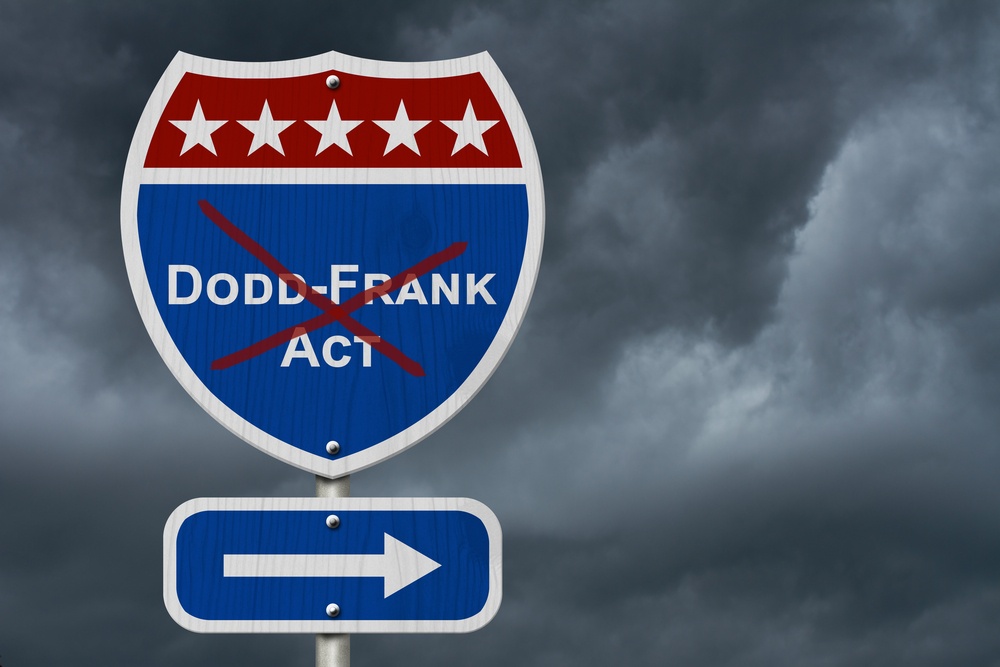Update: Are we there yet?
On March 14, 2018, the Senate passed a bipartisan measure to exempt dozens of small community and regional banks and credit unions from the Dodd-Frank Wall Street reform law enacted in 2010. The bill, which recognizes that smaller financial institutions are disproportionately burdened by regulatory demands, now moves to the House of Representatives, where it faces a tougher approval battle because conservatives believe the Senate version doesn’t go far enough in dismantling Dodd-Frank.
Small community banks are vital to our economy, and provide nearly half of all small business loans, more than 15% of all residential mortgages, and about 44% of farm loans. Since Dodd-Frank was enacted, America has lost 14% of its small banks (with less than $10 billion in assets), giving borrowers fewer options. A rollback of Dodd-Frank rules will provide much needed relief to smaller lenders and community banks by lowering compliance costs and allowing banks and credit unions to better serve their clients, members and shareholders.
Regulatory Threshold Raised From $50 Billion to $250 Billion
A major focus of the reform, the Economic Growth, Regulatory Relief, and Consumer Protection Act, is correcting the unintended harm Dodd-Frank has caused to smaller banks around the country. Dodd-Frank imposed 28,000 new restrictions on banking activities, which were overly onerous and expensive for credit unions and smaller banks.
The version passed by the Senate raises the threshold for Federal Reserve regulatory oversight from $50 billion in assets to $250 billion, which would release dozens of major regional banks and credit unions from stringent reporting requirements that were put in place to prevent mortgage fraud and discrimination.
For instance, banks with less than $250 billion in assets would no longer be subject to yearly stress tests or higher capital requirements that were intended to ensure risky firms could weather a lending crisis. Smaller banks would also be exempt from submitting a “living will” that outlines how they could be liquidated upon failure, without causing a widespread meltdown.
The bill also exempts banks that extend 500 or fewer mortgages a year from reporting some home loan data to federal regulators, and broadens the definition of qualified mortgages. One credit union-specific provision provides that a one-to-four family dwelling, that is not a credit union member’s primary residence, will not be considered a business loan under the Credit Union Act.
Senators backing the bill argue that it would free small banks from unnecessary rules and would help boost investment in struggling communities. Credit unions saw the Senate’s passage of the bill as a great first step to rid the industry of unnecessary and burdensome regulation, and related compliance costs. Critics say the bill is a gift to Wall Street wrapped in false claims that it could rescue smaller lenders.
Provisions Included By Moderate Democratic Senators
To prevent a filibuster from liberals, the Senate version added provisions that mollified moderate Democrats. For example, foreign banks with U.S. holdings of less than $250 billion but above that level in foreign assets would not be exempted, and credit bureaus will still be required to offer free services to victims of identity theft. Additional provisions protect military veterans from fraud, create new student loan backstops, and mandate studies on risks to the financial system.
Senate Version Faces Uphill Battle in House
The House version of Dodd-Frank reform – the Financial Choice Act of 2017 - contains many provisions that the Senate is unlikely to accept. For instance, the House version proposes major changes to the Consumer Financial Protection Bureau’s powers while the Senate bill does little to change the CFPB.
Yet, Senate passage will allow the House and Senate committees to convene to reconcile the two versions, which will be an uphill battle because House conservatives want to see Dodd-Frank significantly stripped of many provisions, and are eager to tout a major rollback of Obama-era rules as they head into midterm elections.
To reach agreement, House Republicans have been breaking many of the provisions in their bill into separate measures that might be acceptable to the Senate. For example, on a 247-169 vote, the House passed H.R. 1116, legislation that would stiffen the requirement that financial regulators tailor their rules based on the business model and risk factors facing institution, including credit unions.
A Weaker Dodd-Frank Seems Inevitable
Since President Trump signed an executive order seeking to ease banking rules, some Dodd-Frank rules have been delayed and others have been enforced with less vigor. While progress has been slow so far, the stage is now set for the House and Senate to hash out their differences, and for lawmakers to capitalize on this opportunity to ease post-crisis financial regulations that would provide much needed relief to community and regional banks and credit unions. However, to come out ahead, banks and credit union will need How to Prepare for the Repeal of Dodd-Frank.
For now, stay tuned on how a compromise between the House and the Senate works its way into law, and let’s hope the final version provides much needed relief to smaller community and regional banks and credit unions.
Update: How to Prepare for the Repeal of Dodd-Frank
How to Prepare for the Repeal of Dodd-Frank in a Rising Interest Rate Environment
With Dodd-Frank squarely on President Trump’s chopping board, and with the Fed widely expected to raise interest rates over the next three years, it’s a win-win for banks to drive-up profits. However, to come out ahead, banks will need to get smarter about freeing-up their cash as capital reserve and regulatory requirements loosen up, and use it to sharply increase lending in a rising interest rate environment. 
The Reprieve for Banks – Fewer Regulations, Lower Reserve Requirements
Following up on his election promise, President Trump signed an executive order in February 2017 that initiated a 120-day review of Dodd-Frank by the U.S. Treasury, and stated that “We expect to be cutting a lot out of Dodd-Frank.” While an all-out repeal of Dodd-Frank appears unlikely, many of its strict mandates on capital reserve requirements and leverage will get watered down, providing much-needed relief to financial institutions (FIs), community banks and credit unions, with reforms expected as early as July 2017.
The Second Win – Rising Interest Rates, Profitable Lending, Strong Loan Demand
After raising interest rates by 25 basis points (0.25%) in March 2017, the Federal Reserve is widely expected to bump-up rates two more times in 2017, by a quarter of a percentage point each. Thereafter, continued strength in the U.S. economy should lead to three quarter-point rate hikes in 2018 and at least three more in 2019.
Add in Trump’s infrastructure spending and proposed tax cuts, and demand for loans could sky-rocket, even as rates head higher, giving banks, especially community banks, the opportunity to profitably boost their loan portfolios. A scenario that will be quite different from the sharply curtailed lending under Dodd-Frank where “lenders reduced credit to middle-class households by 15%, and increased credit to wealthy households by 21%,” according to a recent study from the University of Maryland.
How Banks Can Position Themselves for Dodd-Frank Lite and Rising Rates
Banks must capitalize on these relaxations as soon as they kick in. But to get a head-start over competitors and truly maximize profits, banks will need to go one step further. They should do all they can to identify non-producing assets and optimize them, in real-time, by accurately monitoring metrics such as cash and liquid assets, deposits, reserve requirements and capital allocation.
Branch, ATM, Device and Vault Cash Optimization – The Low Hanging Fruit
Banks can start by quantifying “dead” cash held in vaults, branch ATMs and other devices where it earns nothing, and redeploy it to optimize returns.
Cash is typically a financial institution’s largest non-earning asset, and is held at levels that are 25-35% above what’s really needed. Bank managers routinely over-estimate the amount of cash they need, simply because they do not have the cash management and demand forecasting tools that would give them an accurate snapshot of their “real” needs. This is low-hanging fruit. FIs could easily generate higher returns by deploying freed-up cash and boosting lending.
Minimize Fed Balances to Boost Lending
Banks must also review their Federal Reserve balance, which earns little interest at the Fed Funds rate of 1% (as of 3/16/2017). So it behooves banks to reduce their reserves to the bare minimum through techniques such as Deposit Reclassification that legitimately moves funds from checking accounts (subject to reserve requirements) to savings sub-accounts (NOT subject to reserve requirements) through a retail sweep program. This reduces reserve requirements, improves balance sheet management and frees up cash for more profitable uses.
Quick and Inexpensive Solutions Make Cash and Reserve Optimization Easy
The impending reform of Dodd-Frank legislation presents an attractive opportunity for financial institutions to become more profitable. By leveraging technology for solutions such as deposit reclassification (retail sweep) and cash management, FIs can reclaim their non-producing assets and optimize their under-producing assets, with some solutions allowing FIs to recover their assets as quickly as within 60-90 days.
Financial institutions that prepare ahead for Dodd-Frank Lite by allocating assets for maximum profitability can look forward to a competitive advantage over those who wait until after the reforms are enacted.

